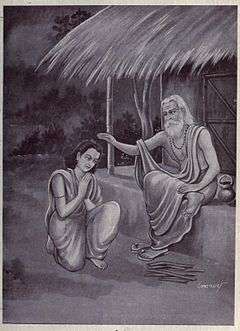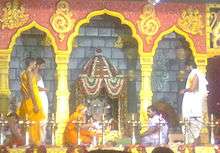Guru Purnima
| Guru Purnima | |
|---|---|
 A guru blessing a student | |
| Official name | Indian and Nepalese teacher's day |
| Observed by | Hindu devotees/disciples Buddhists and Jains |
| Type | Secular |
| Celebrations | National Holiday In India. |
| Observances | guru puja |
| Date | Ashadha Purnima (Shukla paksha, Bright lunar fortnight Full Moon) (June–July) |
| 2015 date | July 31 |
| 2016 date | July 19 |
| 2017 date | July 9 |
| Frequency | annual |
Guru Purnima is an Indian and Nepalese festival dedicated to spiritual and academic teachers. This festival is traditionally celebrated by Hindus, Jains and Buddhists, to pay their respects to their teachers and express their gratitude. The festival is celebrated on the full moon day (Purnima) in the Hindu month of Ashadha (June–July) of the Shaka Samvat, as it is known in the Hindu calendar of India and Nepal.[1] This day marks the first peak of the lunar cycle after the peak of the solar cycle.
Observances
The celebration is marked by ritualistic respect to the guru, Guru Puja. The Guru Principle is said to be a thousand times more active on the day of Gurupurnima than on any other day.[2] The word guru is derived from two words, gu and ru. The Sanskrit root gu means darkness or ignorance, and ru denotes the remover of that darkness. Therefore, a guru is one who removes the darkness of our ignorance. Gurus are believed by many to be the most necessary part of life. On this day, disciples offer puja (worship) or pay respect to their guru (spiritual guide). In addition to having religious importance, this festival has great importance for Indian academics and scholars. Indian academics celebrate this day by thanking their teachers as well as remembering past teachers and scholars.
Traditionally the festival is celebrated by Buddhists in honor of the lord Buddha who gave His first sermon on this day at Sarnath, Uttar Pradesh, India. In the yogic tradition, the day is celebrated as the occasion when Shiva became the first guru, as he began the transmission of yoga to the Saptarishis.[3] Many Hindus celebrate the day in honor of the great sage Vyasa, who is seen as one of the greatest gurus in ancient Hindu traditions and a symbol of the Guru-shishya tradition. Vyasa was not only believed to have been born on this day, but also to have started writing the Brahma Sutras on ashadha sudha padyami, which ends on this day. Their recitations are a dedication to him, and are organised on this day, which is also known as Vyasa Purnima.[4][5][6] The festival is common to all spiritual traditions in Hinduism, where it is an expression of gratitude toward the teacher by his/her disciple.[7] Hindu ascetics and wandering monks (sanyasis), observe this day by offering puja to their guru, during the Chaturmas, a four-month period during the rainy season, when they choose seclusion and stay at one chosen place; some also give discourses to the local public.[8] Students of Indian classical music and Indian classical dance, which also follow the Guru shishya parampara, celebrate this holy festival around the world.
Hindu legend
This was the day when Krishna-Dwaipayana Vyasa – author of the Mahabharata – was born to sage Parashara and a fisherman's daughter Satyavati; thus this day is also celebrated as Vyasa Purnima.[5]Veda Vyasa did yeoman service to the cause of Vedic studies by gathering all the Vedic hymns extant during his times, dividing them into four parts based on their use in the rites, characteristics and teaching them to his four chief disciples – Paila, Vaisampayana, Jaimini and Sumantu. It was this dividing and editing that earned him the honorific "Vyasa" (vyas = to edit, to divide). "He divided the Holy Veda into four, namely Rig, Yajur, Sama and Atharva. The histories and the Puranas are said to be the fifth Veda."
Yogic lore
In yogic lore, it is said that Guru Purnima was the day that saw Shiva become the Adi Guru, or the first Guru. The story goes that over 15,000 years ago, a yogi[9] appeared in the upper regions of the Himalayas. Nobody knew what his origins were. But his presence was extraordinary, and people gathered. However, he exhibited no signs of life, but for the occasional tears of ecstasy that rolled down his face. People began to drift away, but seven men stayed on. When he opened his eyes, they pleaded with him, wanting to experience whatever was happening to him. He dismissed them, but they persevered. Finally, he gave them a simple preparatory step and closed his eyes again. The seven men began to prepare. Days rolled into weeks, weeks into months, months into years, but the yogi’s attention did not fall upon them again.
After 84 years of sadhana, on the summer solstice that marks the advent of Dakshinayana, the earth’s southern run, the yogi looked at them again. They had become shining receptacles, wonderfully receptive. He could not ignore them anymore. On the very next full moon day, the yogi turned south and sat as a guru to these seven men. Shiva, the Adiyogi (the first yogi) thus became the Adi Guru. Adiyogi expounded these mechanics of life for many years. The seven disciples became celebrated as the Saptarishis and took this knowledge across the world.
Guru Purnima is held sacred in the yogic tradition because the Adiyogi opened up the possibility for a human being to evolve consciously. The seven different aspects of yoga that were put in these seven individuals became the foundation for the seven basic forms of yoga, something that has still endured.
Buddhist history
The Buddha went from Bodhgaya to Sarnath about 5 weeks after his enlightenment. Before Gautama (the Buddha-to-be) attained enlightenment, he gave up his austere penances and his friends, the Pañcavaggiya monks, left him and went to Isipatana (Sarnath). After attaining Enlightenment the Buddha, leaving Uruvela, travelled to the Isipatana to join and teach them. He went to them because, using his spiritual powers, he had seen that his five former companions would be able to understand Dharma quickly. While travelling to Sarnath, Gautama Buddha had to cross the Ganges. When King Bimbisara heard of this, he abolished the toll for ascetics. When Gautama Buddha found his five former companions, he taught them, they understood and as a result they also became enlightened. At that time the Sangha, the community of the enlightened ones, was founded. The sermon Buddha gave to the five monks was his first sermon, called the Dhammacakkappavattana Sutta. It was given on the full-moon day of Asadha. Buddha subsequently also spent his first rainy season i.e. Varsha vassa at Sarnath at the Mulagandhakuti. The Sangha had grown to 60 in number (after Yasa and his friends had become monks), and Buddha sent them out in all directions to travel alone and teach the Dharma. All 60 monks were Arahants.
Observances by Buddhists and Hindus
Buddhists observe on this day uposatha i.e. to observe eight precepts. Vipassana meditators practice meditation on this day under the guidance of their teachers. Rainy season i.e. varsha vassa also starts with this day. During the rainy season lasting for three lunar months from July to October. During this time Buddhist monks remain in a single place, generally in their temples. In some monasteries, monks dedicate the Vassa to intensive meditation. During Vassa, many Buddhist lay people reinvigorate their spiritual training and adopt more ascetic practices, such as giving up meat, alcohol, or smoking.
The Hindu spiritual Gurus are revered on this day by a remembering their life and teachings. Vyasa Puja is held at various temples, where floral offerings and symbolic gifts are given away in his honour and that of the cosmic satguru. The festivities are usually followed by feast for the disciples, shishya, where the prasad and charnamrita literally nectar of the feet, the symbolic wash of Guru's feet, which represents his grace, kripa is distributed.[10] As a day of remembrance towards all gurus, through whom God grants the grace of knowledge (Jnana) to the disciples,[10] special recitations of the Hindu scriptures especially, the Guru Gita, a 216 verse ode to Guru, authored by the sage, Vyasa himself, are held all day; apart from singing of bhajans, hymns and organising of special kirtan session and havan at many places, where devotees from all over gather at the ashrams, matha or place where the seat of Guru, Guru Gaddi exists.[11] This day also sees the ritual of padapuja, the worships of Guru's sandals, which represent his holy feet and is seen a way of rededicating to all that a Guru stands for.[12] Disciples also recommit themselves on this day, towards following their teacher's guidance and teachings, for the coming year.[10] A mantra that is particularly used on this day is "Gurur Brahma, Gurur Vishnu, Gurur Devo Maheshwara, Guru Sakshat Parabrahmah Tasmai Shree Guru Veh Namah". This day is also seen as an occasion when fellow devotees, Guru Bhai (disciple-brother), express their solidarity to one another in their spiritual journey.[13]
Observations in Nepal
In Nepal, Guru Purnima is a big day in schools. This day is teacher's day for Nepalese ; mostly Students. Students honor their teachers by offering delicacies, garlands, and special hats called topi made with indigenous fabric. Students often organize fanfares in schools to appreciate the hard work done by teachers. This is taken as a great opportunity to consolidate the bond of teacher-student relationships.
Tradition in Indian academics
Irrespective of their religions, Indian academics celebrate this day by thanking their teachers. Many schools, colleges and universities have events in which students thank their teachers and remember past scholars. Alumni visit their teachers and present gifts as a gesture of gratitude.
Jainism
According to Jain traditions, it was on this day, falling at the beginning of CHAUMASAAS" , the four month rainy season retreat, Mahavira, the 24th Tirthankara, after attaining Kaivalya, made Indrabhuti Gautam, later known as Gautam Swami, a Ganadhara, his first disciple, thus becoming a Guru himself, therefore it is observed in Jainism as Guru Purnima, and is marked special veneration to one's Gurus and teachers.[14]
References
- ↑ Article "Guru Poornima (Vyas Puja)" As on 22 July 2013 on www.Sanatan.org
- ↑ Article "The Guru Principle" As on 22 July 2013 on www.Sanatan.org
- ↑ "The Significance of Guru Purnima". Isha Foundation. Retrieved July 9, 2014.
- ↑ Sharma, Brijendra Nath (1978). Festivals of India. Abhina Publications. p. 88.
- 1 2 Awakening Indians to India. Chinmaya Mission. 2008. p. 167. ISBN 81-7597-434-6.
- ↑ Sehgal, Sunil (1999). Encyclopaedia of hinduism: (H - Q)., Volume 3. 8176250643. Sarup & Sons. p. 496.
- ↑ Sivananda, Swami (1983). Hindu fasts and festivals. Divine Life Society. p. 29.
- ↑ Wadley, Susan Snow (2005). Essays on North Indian folk traditions. Orient Blackswan. p. 64. ISBN 81-8028-016-0.
- ↑ "Classical Yoga: An Introduction to the Origin of Yoga". Isha Foundation. Retrieved March 15, 2013.
- 1 2 3 What Is Hinduism?: Modern Adventures Into a Profound Global Faith. Himalayan Academy Publications. p. 230. ISBN 1-934145-00-9.
- ↑ Sharma, Vijay Prakash (1998). The sadhus and Indian civilisation. Anmol Publications. p. 160. ISBN 81-261-0108-3.
- ↑ Subramuniyaswami, Satguru Sivaya (2003). Dancing With Siva: Hinduism's Contemporary Catechism Volume 1. Himalayan Academy Publications. p. 780. ISBN 0-945497-96-2.
- ↑ Jha, Makhan (1997). Anthropology of ancient Hindu kingdoms: a study in civilizational perspective. M.D. Publications. p. 95. ISBN 81-7533-034-1.
- ↑ ., Mahāvīra (2006). Religion & culture of the Jains. Bhartiya Jnanpith. ISBN 81-263-1274-2.

